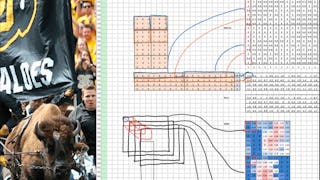Introduction to Computer Vision guides learners through the essential algorithms and methods to help computers 'see' and interpret visual data. You will first learn the core concepts and techniques that have been traditionally used to analyze images. Then, you will learn modern deep learning methods, such as neural networks and specific models designed for image recognition, and how it can be used to perform more complex tasks like object detection and image segmentation. Additionally, you will learn the creation and impact of AI-generated images and videos, exploring the ethical considerations of such technology.

Erwerben Sie mit Coursera Plus für 199 $ (regulär 399 $) das nächste Level. Jetzt sparen.

Introduction to Computer Vision
Dieser Kurs ist Teil von Spezialisierung für Computer Vision

Dozent: Tom Yeh
3.874 bereits angemeldet
Bei enthalten
(23 Bewertungen)
Empfohlene Erfahrung
Was Sie lernen werden
Understand the fundamental principles and algorithms of classical computer vision.
Apply deep learning models to various computer vision tasks.
Evaluate and implement computer vision solutions for real-world applications.
Kompetenzen, die Sie erwerben
- Kategorie: Image Analysis
- Kategorie: Machine Learning Methods
- Kategorie: Deep Learning
- Kategorie: Generative AI
- Kategorie: Feature Engineering
- Kategorie: Digital Signal Processing
- Kategorie: Computer Graphics
- Kategorie: Computer Vision
- Kategorie: Artificial Intelligence
- Kategorie: Data Ethics
- Kategorie: Microsoft Excel
- Kategorie: Convolutional Neural Networks
- Kategorie: Linear Algebra
Wichtige Details

Zu Ihrem LinkedIn-Profil hinzufügen
23 Aufgaben
Erfahren Sie, wie Mitarbeiter führender Unternehmen gefragte Kompetenzen erwerben.

Erweitern Sie Ihre Fachkenntnisse
- Lernen Sie neue Konzepte von Branchenexperten
- Gewinnen Sie ein Grundverständnis bestimmter Themen oder Tools
- Erwerben Sie berufsrelevante Kompetenzen durch praktische Projekte
- Erwerben Sie ein Berufszertifikat zur Vorlage

In diesem Kurs gibt es 4 Module
Welcome to Introduction to Computer Vision, the first course in the Computer Vision specialization. In this first module, you'll be introduced to how this course operates "by Hand" and "in Excel." Then, you'll build a foundation in image matrices and arrays to explore different image types: binary, grayscale, and RGB. Next, you'll transition into using functions to perform basic image operations such as addition, negation, and masking. You'll then be introduced to the concept of image transformation through linear algebra. Finally, you'll perform translation, scaling, and rotation matrix operations.
Das ist alles enthalten
34 Videos8 Lektüren8 Aufgaben
This module dives into feature extraction—quantitative measures that describe image content. Students compute features such as image mass, center, and statistical moments to describe the shape and structure of images. These are implemented both manually and in Excel. The module also explores how to compare images using distance metrics and similarity measures, offering insight into how visual data can be analyzed, categorized, and classified.
Das ist alles enthalten
23 Videos2 Lektüren5 Aufgaben
Filtering techniques are central to detecting patterns in images. This module introduces learners to 1D and 2D filters, covering foundational concepts like convolution, cross-correlation, and Gaussian smoothing. Through both manual and spreadsheet-based exercises, learners apply various filters (e.g., mean, Laplacian, Sobel) and morphological operations like dilation and erosion. These filtering methods enhance image features, detect edges, and prepare data for further processing.
Das ist alles enthalten
26 Videos2 Lektüren5 Aufgaben
This module delves into key concepts of camera models and their role in computer vision and photogrammetry. You will learn about the Extrinsic Matrix, exploring how it defines the position and orientation of a camera in 3D space. Understand the Pinhole Camera Model, a simplified optical system that forms the basis for many computer vision applications, alongside the Intrinsic Matrix, which captures the internal parameters of the camera. Epipolar geometry is examined, with a focus on its significance in 3D reconstruction and stereo vision. The module covers the motivation behind epipolar geometry, breaking down its basic components, and explaining the Essential Matrix, which encapsulates the geometric relationship between camera views, as well as the Fundamental Matrix, a core component in epipolar geometry that represents the relationship between two cameras in stereo vision.
Das ist alles enthalten
15 Videos3 Lektüren5 Aufgaben
Erwerben Sie ein Karrierezertifikat.
Fügen Sie dieses Zeugnis Ihrem LinkedIn-Profil, Lebenslauf oder CV hinzu. Teilen Sie sie in Social Media und in Ihrer Leistungsbeurteilung.
Auf einen Abschluss hinarbeiten
Dieses Kurs ist Teil des/der folgenden Studiengangs/Studiengänge, die von University of Colorado Boulderangeboten werden. Wenn Sie zugelassen werden und sich immatrikulieren, können Ihre abgeschlossenen Kurse auf Ihren Studienabschluss angerechnet werden und Ihre Fortschritte können mit Ihnen übertragen werden.¹
Dozent

Mehr von Algorithms entdecken
 Status: Kostenloser Testzeitraum
Status: Kostenloser TestzeitraumMathWorks
 Status: Kostenloser Testzeitraum
Status: Kostenloser Testzeitraum Status: Kostenloser Testzeitraum
Status: Kostenloser TestzeitraumUniversity of Colorado Boulder
Warum entscheiden sich Menschen für Coursera für ihre Karriere?




Häufig gestellte Fragen
To access the course materials, assignments and to earn a Certificate, you will need to purchase the Certificate experience when you enroll in a course. You can try a Free Trial instead, or apply for Financial Aid. The course may offer 'Full Course, No Certificate' instead. This option lets you see all course materials, submit required assessments, and get a final grade. This also means that you will not be able to purchase a Certificate experience.
When you enroll in the course, you get access to all of the courses in the Specialization, and you earn a certificate when you complete the work. Your electronic Certificate will be added to your Accomplishments page - from there, you can print your Certificate or add it to your LinkedIn profile.
Yes. In select learning programs, you can apply for financial aid or a scholarship if you can’t afford the enrollment fee. If fin aid or scholarship is available for your learning program selection, you’ll find a link to apply on the description page.
Weitere Fragen
Finanzielle Unterstützung verfügbar,






